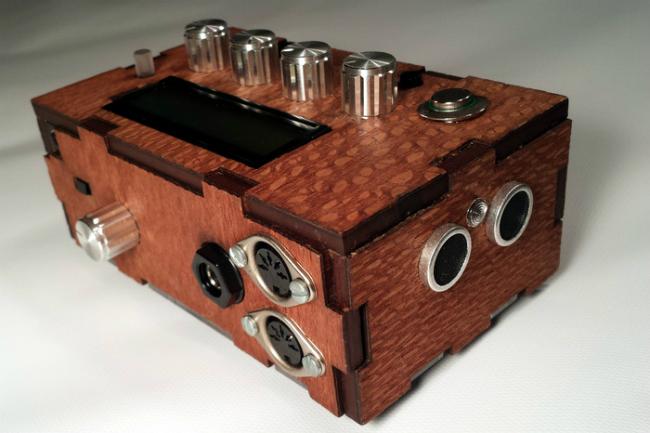
Related: This glitch lets you Rickroll any TV armed with a Chromecast
Like the theremins of old – eerie sounding instruments that measure the movements of the players hands to control characteristics like pitch and volume – the M!lTone requires no physical contact to control its parameters. But instead of the theremin’s ancient twin antenna design, the M!ltone is equipped with two ultrasonic sensors that allow the user to manipulate and control audio, lights, and video by using a reflective surface. Details are a bit mirky as to how these aspects will fit into the overall functionality, but Villeda’s main goal seems to be to unleash a barrel of creativity to let each user discover and decide what the M!ltone can do.
There are a number of very cool ways in which musicians and visual artists alike will be able to enlist the mad scientist gizmo. First off, there are three distinct modes: Discrete Air, Continuous Air, and Weighted Air. Discrete Air mode sounds like it might be the best bet for those looking to craft a melody or tune. The user can select from a preloaded bank of 200 scales culled from various cultures to add subtle changes to the piece’s mood. One can either use the M!ltone’s built-in speaker or hook it up to an amplifier.
Users can employ up to three voices with individually assignable wave types and note offsets to create truly unique compositions. One can even assign each voice to independent MIDI (Musical Instrument Digital Interface) channels, which will feed coded commands to synthesizers to create an ensemble with just one device. Not enough? Throw in a couple more M!ltones for some daisy-chaining madness.
Next comes the Continuous Air mode, the M!lTone feature that most closely resembles the oddball oscillations of a theremin. Users can choose from several popular wave types to manipulate, such as the sine, triangle, square, and saw which essentially allows for users to create their own synthesizer effects.
And finally there’s the Weighted Air mode, a blend of the Continuous and Discrete modes. Villeda explains on his Kickstarter page for the M!lTone that this “weighted hands-free mode nicely pitch-bends the notes in between a scale to the next note in the scale.” This mode also allows one to perform a “divebomb” effect. You can listen to what each of these strange player modes sound like below:
And if these three modes and their respective functionalities bore you, you’re in luck! The M!lTone is open-source and compatible with Arduino, an electronics platform based on easy-to-use hardware and software that allows users to write their own code.
“There are countless projects online that can be modified to work with the M!lTone,” Villeda claims. “It is designed to be a simple and robust audio/electronics platform for musicians, hackers, electronic enthusiasts, and anyone willing to explore the world of audio synthesis.”
When his already successful campaign comes to a close, he plans to host a forum on his website where people can upload their versions of the M!lTone software, and download future releases of the source code. Villeda’s device can either run on a DC adapter, 9V battery, or solar power, and each completed device sits inside of a wooden enclosure with a “randomly selected exotic veneer.”
For those with a mind for electronics, and a wildly creative spirit, the M!lTone could be the perfect catalyst to take projects from the mild and mundane, into new realms of sight and sound.


